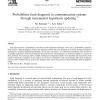Free Online Productivity Tools
i2Speak
i2Symbol
i2OCR
iTex2Img
iWeb2Print
iWeb2Shot
i2Type
iPdf2Split
iPdf2Merge
i2Bopomofo
i2Arabic
i2Style
i2Image
i2PDF
iLatex2Rtf
Sci2ools
103
click to vote
CN
2004
2004
Probabilistic fault diagnosis in communication systems through incremental hypothesis updating
This paper presents a probabilistic event-driven fault localization technique, which uses a probabilistic symptomfault map as a fault propagation model. The technique isolates the most probable set of faults through incremental updating of a symptom-explanation hypothesis. At any time, it provides a set of alternative hypotheses, each of which is a complete explanation of the set of symptoms observed thus far. The hypotheses are ranked according to a measure of their goodness. The technique allows multiple simultaneous independent faults to be identified and incorporates both negative and positive symptoms in the analysis. As shown in a simulation study, the technique offers close-to-optimal accuracy and is resilient both to noise in the symptom data and to inaccuracies of the probabilistic fault propagation model.
CN 2004 | Fault Propagation Model | Probabilistic Event-driven Fault | Probabilistic Symptomfault Map |
| Added | 16 Dec 2010 |
| Updated | 16 Dec 2010 |
| Type | Journal |
| Year | 2004 |
| Where | CN |
| Authors | Malgorzata Steinder, Adarshpal S. Sethi |
Comments (0)

